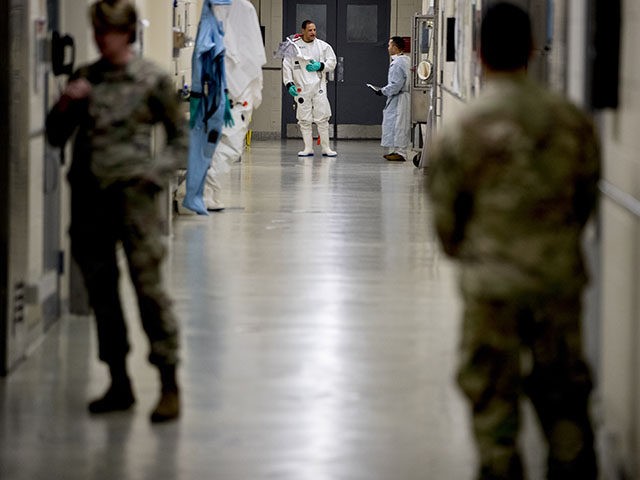The Associated Press published an extensive report on Monday about the Chinese government’s promotion of an elaborate conspiracy theory that claims the Wuhan coronavirus is a bioweapon created in a U.S. Army laboratory.
As Breitbart News has been reporting for nearly a year, Chinese government officials have openly promoted this theory without providing any evidence that the Chinese coronavirus originated anywhere but Wuhan, China, where the first cases were reported. The Associated Press (AP) called China out as the world’s leading disseminator of coronavirus disinformation on Monday, telling the story of how “a rumor that the U.S. created the virus that causes COVID-19 [Chinese coronavirus] was weaponized by the Chinese government, spreading from the dark corners of the Internet to millions across the globe” through millions of social media posts.
One of the first Chinese officials to push this propaganda was Foreign Ministry spokesman Zhao Lijan, who accused the U.S. military of creating the Chinese coronavirus in March, a few weeks after Chinese state media published a flurry of articles questioning if the pandemic truly began in Wuhan:
Zhao was never reprimanded or disciplined for spreading these conspiracy theories. He rose to prominence in the Chinese Communist Party by flinging insults and snide innuendo at the United States on social media, and he never stopped. He is still one of the primary mouthpieces for the Chinese Foreign Ministry. His social media following is ostensibly bigger than ever, assuming his following is not padded out with fake accounts and bots.
According to the AP, the Chinese conspiracy theory was created as a somewhat panicked response to growing suspicions in the Western world that the Chinese coronavirus might have escaped from the high-level virus research lab near Wuhan. This was not merely speculation by random denizens of the Internet; some high-level U.S. officials, notably including former Secretary of State Mike Pompeo, said they have seen evidence that suggests the pandemic “likely came from the Wuhan Institute of Virology.”
In the early days of 2020, China allegedly punished citizens who floated conspiracy theories about the United States creating the coronavirus and deliberately unleashing it upon Wuhan, but soon the very same theory was deemed politically expedient by the Chinese government, repackaged, and spread across the world by China’s diplomatic corps, social media accounts, and state media outlets — and even through a few Western media outlets paid to republish Chinese propaganda.
Russia’s notorious disinformation operation, and later Iran, chipped in to amplify China’s efforts, perceiving the coronavirus conspiracy theories as harmful to American interests. Russian state media was actually quicker than China to fabricate an “American bioweapon” story about the coronavirus, and it was spread not only by bots and Kremlin media proxies but by Russian politicians as well.
The AP suggested China developed its own conspiracy theory not only in response to suspicions about the Wuhan Institute of Virology, but also to deflect anger from the Chinese public over the death of whistleblower Dr. Li Wenliang and to confuse and bully the rest of the world out of viewing China as the source of the pandemic.
China’s official conspiracy theory went through a few rough drafts before achieving its final form in March, a few days before Foreign Ministry spokesman Zhao Lijian began pushing it:
On March 9, a public WeChat account called Happy Reading List reposted an essay claiming the U.S. military created SARS-CoV-2, the virus that causes COVID-19, at a lab at Fort Detrick, in Maryland, and loosed it in China during the Military World Games, an international competition for military athletes, held in Wuhan in October 2019.
The account, which has been suspended, was registered in May 2019 by a woman from Henan province in central China, who did not reply to messages. It’s not clear who first wrote the article, which can still be found on other WeChat accounts.
The next day an anonymous petition appeared on the White House’s now-defunct “We the People” portal. It urged U.S. authorities to clarify whether the virus had been developed at Fort Detrick and leaked from the lab. The petition was lavishly covered by China’s state media, despite getting only 1,426 signatures, far shy of the 100,000 needed to merit a response from the White House.
The AP noted that Twitter eventually added a “fact-check warning” to Zhao’s scurrilous posts — but only to the English translations of his tweets, not the Mandarin-language versions. Zhao’s dozen tweets accusing the U.S. Army of creating the coronavirus mutated into a hundred thousand citations and retweets in 54 languages, including signal boosts from Chinese and allied officials, plus friendly coverage by Russian and Iranian state media.
Soon enough, Iran’s Supreme Leader Ayatollah Ali Khamenei and his clerics were accusing the American military of creating the coronavirus, and the same disinformation networks pushed their propaganda, creating a vicious triangle of liars in Beijing, Moscow, and Tehran citing each other as “proof.”
Then American conspiracy theorists and political operatives began circulating the propaganda from China, which attracted coverage from Chinese, Russian, and Iranian media, starting the cycle of disinformation all over again.
Zhao took a little victory lap at the end of March, chirping “Thank you for your support to me, let us work hard for the motherland!” along with an emoji of a flexing bicep. His scurrilous work was resurrected in May when China lashed out at Australia for demanding an independent investigation into the origins of the coronavirus; Chinese state media swiftly cranked out a “documentary” suggesting that investigation should begin in Fort Detrick, Maryland. Somehow YouTube forgot to label the documentary as state-sponsored propaganda when it was uploaded, so it was circulated around the world, and even unwittingly rebroadcast by a TV station in Houston, Texas.
During its long-delayed visit to Wuhan last week, the World Health Organization concluded it was “extremely unlikely” the coronavirus emerged from any laboratory.

COMMENTS
Please let us know if you're having issues with commenting.